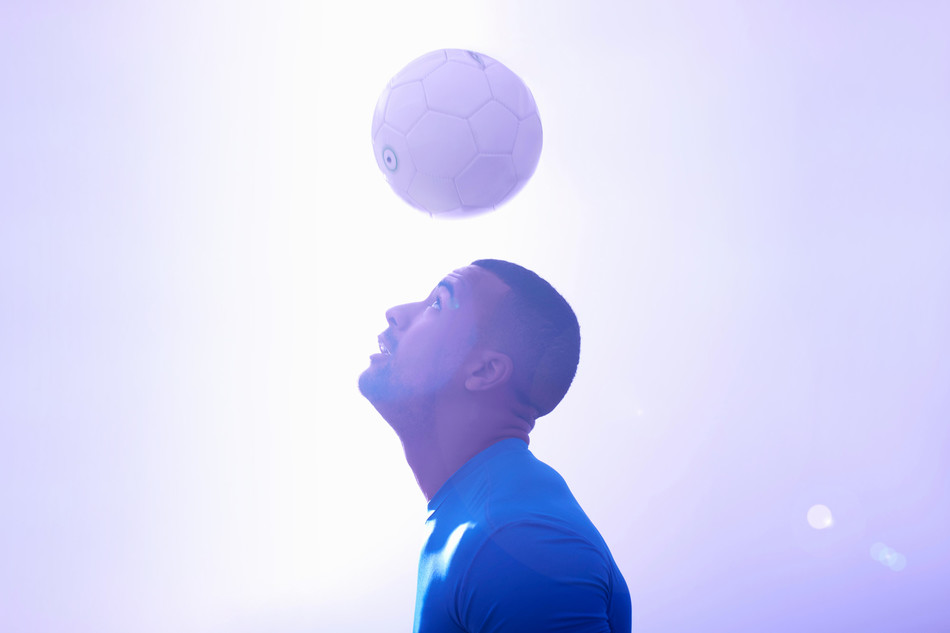Weighing less than a pound, made of light synthetic materials (heavy leather balls went out in the 1980s), and soft to the touch, a soccer ball would seem to pose little threat to human health — especially when shooting off a skilled player’s forehead into the opposing net.
But a team of researchers led by Michael Lipton, a Columbia radiologist and neuroscientist who has spent fifteen years scrutinizing soccer’s most charismatic maneuver, has found compelling evidence that amateur adult players who frequently head the ball show long-term changes in brain structure and function.
Lipton says that his two new studies, which tracked hundreds of recreational soccer players for two years in the New York City region, are the first to indicate that soccer heading causes measurable brain damage. “Past research had shown that soccer players display neurological changes within hours or days of heading the ball, or perhaps across a season of play, but no one had documented a decline over the longer term in a controlled study,” he says.
These effects are fairly subtle, involving a decline in the integrity of neural networks in various parts of the brain and a small but significant drop in performance on memory tests. And Lipton is quick to point out that many questions about the impact of heading remain unanswered, such as the cumulative damage that it may cause over a career, whether there is a safe threshold for the number of headers that a player might execute in a given time frame, and whether playing soccer may have cognitive benefits that outweigh the risks for some people. “Few studies have investigated these questions, so players, parents, and coaches don’t have good information to guide them,” he says.
Participants in Lipton’s studies were all avid soccer players who practiced or competed several times a week, but their approach to the game varied considerably, with some rarely if ever heading the ball and others doing so regularly. This enabled the researchers to measure the effects of heading on players’ health while controlling for other factors such as their age, sex, overall level of fitness, and whether they received any accidental blows to the head or suffered concussions in the course of play.
“We also accounted for concussions that people had experienced over their lifetimes and found that these didn’t explain the structural and cognitive effects that we saw in this population,” says Lipton. “The only thing that did account for the brain changes was the number of times they headed the ball.”
Lipton’s research found that only the most prolific headers in their cohort — those who used the move 1,500 or more times per year — showed signs of brain damage and cognitive decline. “These are players who may routinely do drills where they’re heading the ball thirty or forty times in quick succession at practice,” he says. “Some head the ball thousands of times per year.”
The cognitive changes that these participants experienced over the course of the research were not so pronounced as to likely be noticeable to them or anyone else. “Their mental function was still within the normal range,” Lipton says. But the findings suggested that “these folks might be a little bit sharper, with better working- and verbal-memory performance, if it weren’t for heading the ball.”
Past research by Lipton’s group has found that recreational soccer players who head the ball fewer than one thousand times per year have cognitive abilities on par with those of serious runners, swimmers, and other endurance athletes whose exceptional fitness has been shown to significantly boost brain health. Lipton suspects that soccer players who exceed that amount of heading gradually deplete the neurological benefits of the aerobic exercise they engage in. “The participants in our study who headed the ball the most frequently had cognitive abilities comparable to healthy non-athletes, but lower that athletes who do not experience repeated head impacts,” he says. “They do no exhibit the enhancement of cognitive performance we would otherwise expect in a high-intensity athlete.”
James Noble ’08PH, a Columbia neurologist who has consulted for collegiate and professional sports teams on their concussion-monitoring programs, says Lipton’s research sheds important light on an underreported hazard. “There’s been so much attention paid to sports-related head injuries in recent years, but most of the conversation so far has focused on concussions, and it’s clear now that we also need to be talking about the cumulative burden of exposure to sub-concussive injuries.”
Lipton’s team is currently conducting a large five-year study to better understand soccer’s risks and benefits for brain health; the researchers are also investigating how players’ genes, concussion histories, and heading exposures may combine in ways that could eventually influence their susceptibility to severe neurodegenerative conditions like chronic traumatic encephalopathy (CTE) and Alzheimer’s disease.
“Is it possible that years of soccer heading could tilt the scales for certain individuals and cause them to develop serious problems down the road? This is important for us to understand,” Lipton says.
Ultimately, his team’s work could have implications far beyond the soccer pitch. “By studying athletes, we hope to gain insights that could benefit others,” Lipton says. “For example, we might find that the cognitive benefits of exercise could be leveraged to help people recover from traumatic brain injuries. There are lots of opportunities there.”



